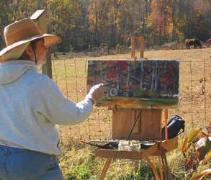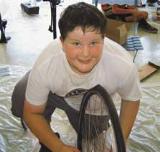SEO Version



rails
to
trails
u
winter.12
24
community connections
MARYLAND
The Art of Rail-Trails
When the
opened in rural Charles County, Md.,
county parks chief Tom Roland expected
that cyclists, runners and birdwatchers
would be drawn to it. And he wasn’t
disappointed: Tese folks quickly took
advantage of the 13-mile asphalt path-
way, which passes through forests, wet-
lands, farms and small towns about 30
miles south of Washington, D.C.
Built in 1918 as a supply route for
the U.S. Navy’s Indian Head Powder
Factory, the rail line was in regular use
until the 1960s. In 2006, the National
Park Service gave the unused railroad
corridor to the county, which spent $3
million to convert it into a trail and
opened the entire path in October 2009.
What Roland didn’t anticipate were
the three women who started showing
up on the new trail with easels, canvasses
and paintbrushes. “I didn’t really even
consider the attraction this would be for
artists,” he says.
Te three—Barbara Stepura, Lynn
Mehta and Sally V. Parker—are local
residents who specialize in
plein air
(the
French term for “outdoor”) painting.
Always on the lookout for safe and sce-
nic spots to practice their craft, the trio
immediately saw an opportunity in the
new rail-trail.
“One of the gals said, ‘Why don’t
we just paint right here along the trail,
because it’s gorgeous,’” says Stepura, a
retired hospital executive from White
Plains, Md. “It was ideal, because it had
parking places,
and there was
a nice path…it
was real wide, so we could set our things
up and not impede the fow of trafc.”
About once a week for the next year
and a half, the women would drive out
to diferent access points along the trail;
unload their painting equipment, lunch-
es, water and umbrellas; set up at scenic
spots; and begin to paint. Tere was never
a shortage of subject matter, Stepura says:
from blazing fall foliage to glistening
wetlands to bucolic farmland to majestic
eagles and ospreys, to the ever-changing
parade of runners, walkers and cyclists.
“Cyclists on the Trail” and 64 other
paintings by the artists were recently the
focus of “Rail Trail Impressions,” a show
at the Mattawoman Creek Art Center, a
nonproft gallery just a few miles south of
the trail. Te opening reception for the
exhibit in May 2011 was reportedly the
largest-ever for the gallery—thanks to the
presence of several dozen members of the
local Oxon Hill Bicycle and Trail Club,
who pedaled to the gallery to show their
support for the artists and the trail.
“We made it very clear beforehand—
because you know how formal these
receptions can be—that bike attire was
fully appropriate for the event,” says
Roland, who is also a member of the
club. “I could see people walking around
the exhibit saying, ‘I know where that is,’
or ‘Tat’s where I saw an egret last time I
was down there.’ It was really awesome.
Te ladies did a really wonderful job.”
Te three artists have since moved on
to their next project—painting images
of the waterways in the area. But their
work has blazed a path for other paint-
ers. “It helps us get the word out that
these trails are valuable not only as an
outdoor recreational resource, but as a
cultural resource for our communities,”
says Roland.
For more information about the
Indian Head Rail Trail, visit
www.
charlescounty.org/pf/parks_rec/parks/
trails.jsp
or call the county parks ofce
at 301.932.3470.
ILLINOIS
Learning, Earning and
Turning the Wheels
In a previously empty storefront in the
business district in Blue Island, Ill., a bit
of magic occurred last June. A bike shop
materialized there on a Saturday morning,
stafed by 17 young mechanics—each of
them eager to tune up bikes. For free.
Tis economically struggling, multi-
ethnic community just south of Chicago
previously didn’t have its own bike
shop. But for four hours on that special
Saturday, residents were able to haul dam-
aged and dusty steeds out of their garages
and have fats fxed, chains greased,
brakes adjusted and other repairs made at
the Cal-Sag Cycles Pop-Up Bike Shop.
Te one-day bike bonanza was a joint
efort by Friends of the Calumet-Sag
Trail, the Active Transportation Alliance,
community leaders and local businesses,
and with fnancial support from Rails-
to-Trails Conservancy (RTC).
A $12,000 grant from RTC—part of
its Metropolitan Grants Program, fund-
ed by Te Coca-Cola Foundation—to
the Calumet-Sag trail group last spring
launched an “earn-a-bike” program for
17 underprivileged teenagers from Blue
Island schools. Te students received two
weeks of training from adult bicycle-
repair experts. To give the kids the
chance to practice their newfound skills,
project organizers created the pop-up
bike shop in a storefront on Western
Avenue, which drew nearly 100 patrons
during that single day.
“Te whole program here at Cal-Sag
Cycles is about getting kids on bikes,
it’s getting people to realize they can use
At left, Sally Parker sets up shop along the Indian
Head trail; a recumbent cyclist models for a
painting.
Courtesy of Barbara Stepura (2)
An eager
worker at
the Cal-Sag
Pop-Up Bike
Shop.
Rhonda Boose-Romano
Powered by FlippingBook Publisher

